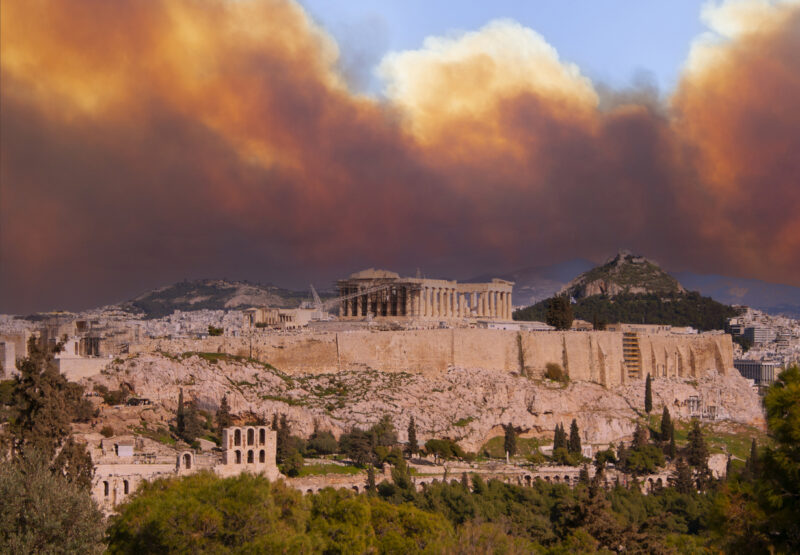El Niño is contributing to the hottest temperatures ever recorded – what does this mean for the Paris Agreement’s 1.5°C limit?
Extreme weather is raging across the northern hemisphere. Our experts explain the implications of the emerging El Niño for our changing climate.
Share

Summer in the northern hemisphere is breaking temperature records back-to-back. However, a common misconception we’re seeing reported is that this emerging El Niño will drive temperatures above the 1.5°C goal of the Paris Agreement. This isn’t the case, and it’s important for people to understand why.
Provisional data on global average temperatures from the first week of July has led the World Meteorological Organization to declare it the hottest week on record. Iran has recorded apparent temperatures of 66°C at the Persian Gulf International Airport, with 65% humidity creating dangerous conditions for human health. Above certain wet bulb temperatures humans lose the ability to cool themselves down, and while this is particularly bad for vulnerable groups such as the elderly, even healthy people can suffer life threatening consequences.
Mediterranean countries are likewise facing temperatures that are approaching 50°C as a reverse cyclone leads to heat domes stilling over the South of Europe. Wildfires are forcing evacuations and heat alerts have been issued telling people to avoid being outside in the hottest parts of the day.
In Canada, the army has been deployed to help combat forest fires, with the smoke drifting over the continent leading to US cities recording the worst levels of air pollution in the world. Beijing has registered a record 27 days during which the temperature exceeded 35 degrees Celsius.
In Florida coral reefs are bleaching as sea temperatures reach record levels and in the Caribbean the outlook is for severe bleaching.
In some cases, the concurrent nature of these extremes is exacerbating their impact. Disaster responses can fail when we have to deal with them all at once.
Hospitals are filling up, water resources are getting scarcer – and these kind of immediate impacts also have longer term repercussions – like crop failure in multiple regions that are key to global food supply chains. Economic impacts like labour productivity also are due to take a big hit, especially for sectors that rely on outdoor work.
It’s scary, but it’s not unexpected. Climate models have been telling us that this is where continued high emissions would take us. And the impacts of this summer have not emerged in isolation. Just look at the recent drought in the Horn of Africa, or the flooding in Pakistan last year that left a third of the country underwater.
But these record-breaking heat extremes that grab headlines are going to be seen more and more often as the El Niño cycle ramps up in the next few years. El Niño refers to one half of the multi-year pattern called the El Niño Southern Oscillation, or ENSO, where sea surface temperatures rise and release heat into the atmosphere.
The previous record for hottest year was set in 2016 during the last El Niño. Since then, the cooling effects of La Niña – the sister to El Niño – have been tempering the effects of climate change. This means the extreme heat in Europe last summer that sparked wildfires and led to 20,000 excess deaths could have been much worse, as could the heatwaves in the US, China, India and Australia.
Now, as the ENSO shifts and El Niño begins once more, we can expect higher temperatures and the dangers that come with them.
What’s more is that there is evidence that the ENSO is getting more extreme due to global warming; the emerging El Nino therefore could be supercharged because of the build-up of energy in oceans driven by rising greenhouse gas concentrations.
But, while El Niño is contributing to heat extremes, the 1.5°C goal set out in the Paris Agreement refers to long-term temperature change, measured over two to three decades so that natural fluctuations are filtered out and climate change can be identified.
The combined effect of spikes from intense El Niño phases and ongoing global warming might well lead to a situation where global average temperature levels rise to 1.5°C in a single year. But one year does not bust a goal measured over a longer period of time – although it is a very stark warning.
By the time that warming reaches 1.5°C as a long-term average, it’s reasonable to suspect that every second year would record an average temperature above 1.5°C. Sometimes the apparent smallness of this figure masks the very dire circumstances it entails for impacts at the local scale; this would considerably increase the compounding effects from heat, fires, water shortages, and hospital admittances compared to what we’re seeing at the current 1.2°C of warming.
We have not breached 1.5°C yet. But it’s important to remember that we will get there if we do not urgently course correct and halve emissions by 2030 and get to net zero CO2 by 2050. It is only once emissions get to zero that warming will stop.
The extraordinary weather extremes observed during this summer need to motivate governments to act faster on climate change, as action in line with science has been delayed for too long. If we wait, it will be too late for 1.5°C, and we risk triggering tipping points that can alter our climate in ways that we cannot predict.












